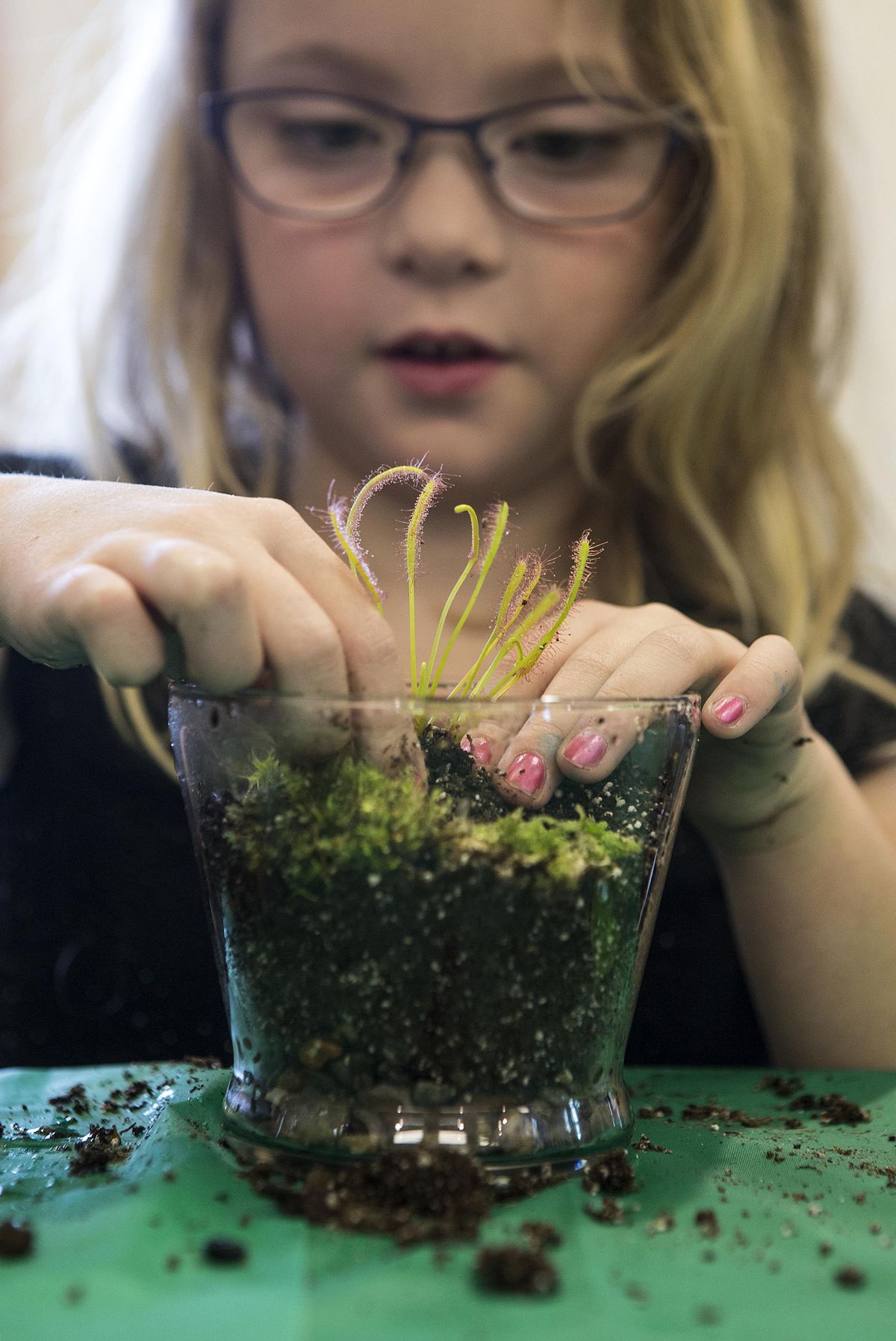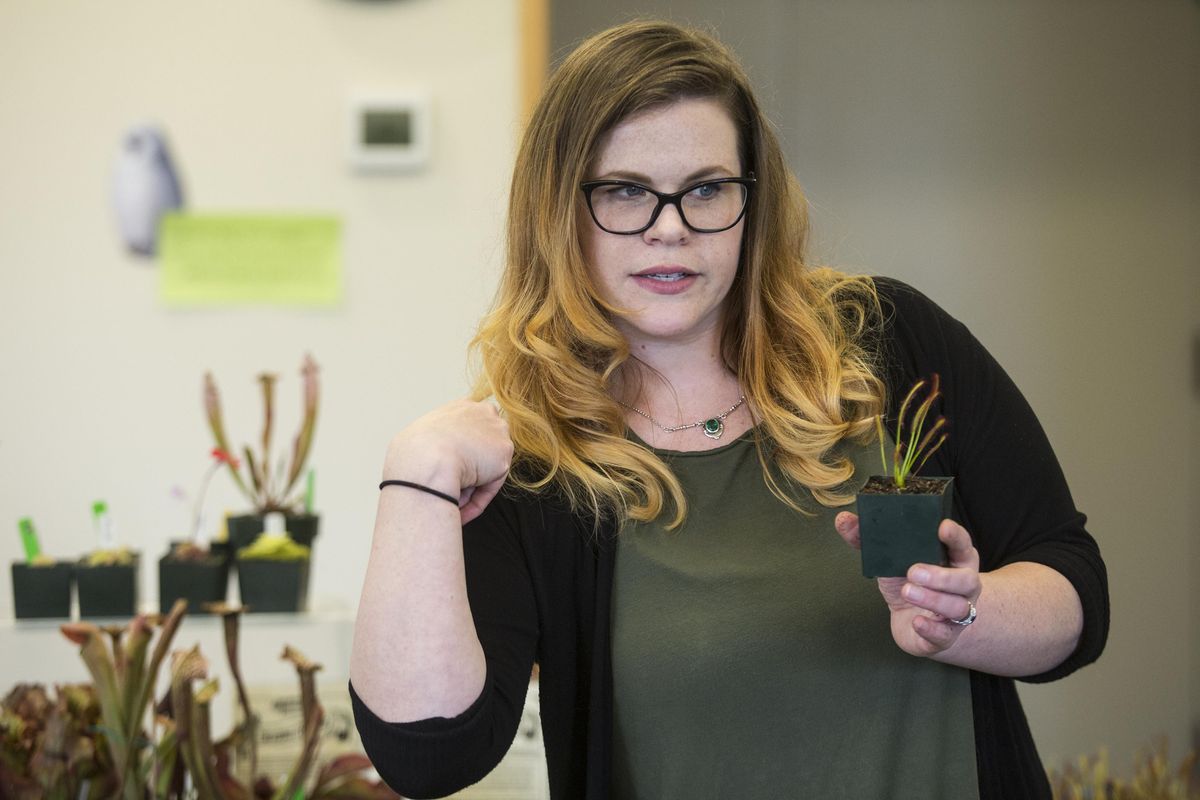Everett woman’s business is all about bug-eating plants
This photo taken March 27, 2018, shows Anna Curry, 7, pushing a Sundew plant into the soil as she makes a terrarium for the carnivorous plant while at the Darrington Library in Darrington, Wash. (Andy Bronson / Associated Press)
EVERETT, Wash. – Class was about to start. Mary Fosse ran outside the Darrington Library, turning over rocks, looking for bugs.
Fosse, 35, runs a small business called “Carnivorous Terrariums” out of her home in northeast Everett. She travels to libraries, schools and birthday parties, teaching children and adults about insect-eating plants.
Everyone in class gets to create their own terrariums. On a recent Tuesday in Darrington, the room was full of sundews, which eat fruit flies.
Life is busy: Fosse has a 1-year-old son and a part-time office job. She’s also an active volunteer who leads the Delta Neighborhood Association.
Fosse bought her house in Everett in 2006 and met her husband at Tony V’s on Hewitt Avenue. She started “Carnivorous Terrariums” in 2011.
She’s always been a gardener, and the 1924-vintage house proved great for humidity, for plants at least. There are hundreds of varieties of carnivorous plants, beyond the Venus flytrap or Audrey II from “Little Shop Of Horrors.”
Fosse didn’t major in science, but while she was studying history at Whitman College she found herself drawn to a building on campus that housed bug-eating plants.
After school, her career mostly involved event planning, but at home she got into making terrariums. She found the teensy environments suited carnivorous plants, many of which are low maintenance and slow growers. Then she began to set up booths at craft shows.
“People started asking me to come teach them how to do it,” she said.
Sno-Isle Libraries extended an offer. Since then, business has relied on word of mouth, she said. It tends to be seasonal, just like the plants.
Through trial and error, Fosse has learned what conditions work best for her students, who don’t tend to be the “extreme interest carnivorous plant growers,” she said.
She teaches about building terrariums in plain language. Think about the roots as underpants: They shouldn’t be showing. Don’t crunch down the moss too much. Just two or three rocks. Spray with water once or twice a week – after you take an oath not to spray your neighbor during class.
Here’s a bit of Charles Darwin trivia (his favorite plants were carnivorous). Did you know that some pitcher plants have a symbiotic relationship with bats? (The bat poo gives it nutrients and the bat has a place to live.)
“The education part is really easy to fit in there,” she said. “It’s a topic that’s just exciting. It’s one of those things that appeals to all ages.”
Tia Curry brought her daughter, 6-year-old Hannah, to the Darrington class. Some carnivorous plants grow to Hannah’s size, Fosse said, making the girl’s eyebrows shoot up. Hannah’s favorite plant on display was the cobra lily, which resembles its namesake.
Carsen Frazee, 11, had done his research, raising his hand over and over to share his knowledge, right down to the plants’ use of digestive juices, also known as enzymes. Some of the traps work like “a crazy light maze,” he said. “The bug gets confused and tries to break out.”
The sundew “kind of looks like a squid’s tentacles,” said Masyn Fugate, 10, of Concrete. He was accompanied by his great aunt, Dawn Lowrey, who recently moved to Darrington. She pronounced her terrarium “pretty cute.”
Fosse also sells plants and terrariums, starting at $5. As part of her volunteering, she donates arrangements to community fundraisers, such as an upcoming auction for North Middle School.
She can go fancier, too, like when she did her wedding florals in North American pitcher plants. Those are the ones that grow upright with elegant, tube-shaped traps.
“They come in such beautiful colors,” she said. “When they come up, they are just a gorgeous array of reds and whites and yellows. I think everyone should get one for their wedding.”
Visitors to her house always seem to get a tour of the back yard and the greenhouse.
“I have quite a little collection,” she said. “Luckily, carnivorous plants are pretty small so you can have a lot without taking up too much room. I am pretty skilled at collecting bugs. If I come across a pesky mosquito that I just stunned, I’ll happily feed it to my plants.”

